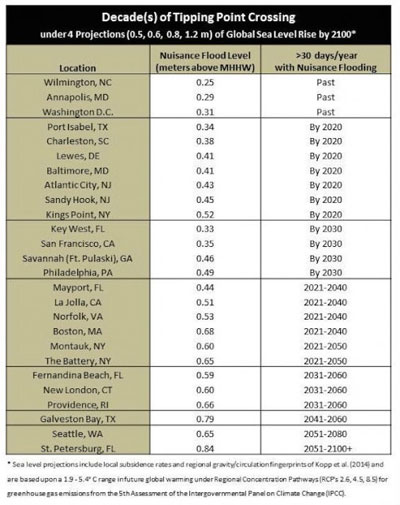A multitude of scary studies are released on an on-going basis about the progression of climate change, but we keep our reporting confined to the big ones, like these:
In the US, Miami and New Orleans are literally guaranteed to be inundated by rising sea levels – even if emissions halted today, it is too late. "Miami’s low elevation and porous limestone foundation [which easily absorbs water] mean that sea walls and levees won’t help," lead author Ben Strauss at Climate Central told Huffington Post. New Orleans is in even worse shape because of how flat it is and the fact that it is already sinking.
"Even in a best-case carbon emissions scenario, 98 percent of populated land in New Orleans would be below the future sea level," he says.
The states most at risk are Florida, California, Louisiana and New York, in that order. 414 towns and cities have "lock-in dates" – when they are past the point of no return for at least half their populated land area – if emissions continue as they are now. In the worse case scenario, NYC could be unlivable by 2085.
The study, "Carbon Choices Determine US Cities Committed to Futures Below Sea Level," published in Proceedings of the National Academy of Sciences, concludes these changes are locked in unless world emissions peak by 2020 – which isn’t happening (so far).
"The most interesting thing to me is there are a great number of cities where our carbon choices can still make a huge difference," notes Strauss. "For example, if you look at Philadelphia, under business as usual, land that accounts for more than 100,000 people could be submerged. But you divide that total by 10 with an extreme carbon cut. The very biggest difference of all is for New York City, where you can avoid submergence of land where one and a half million people live." The same is true for Virginia Beach, Jacksonville, Florida, Sacramento and other cities.
Other studies show that by 2050, floods will be a monthly occurrence in about 24 major cities, and in some floods could be a daily fact of life by the 2070s.

Antarctica is melting much faster than expected, and a study published in Nature this week concludes that only steep emission cuts during the next 10 years will prevent catastrophic collapse of its ice sheets – leading to uncontrollable sea-level rise that lasts thousands of years.
Right now, countries’ climate pledges aren’t strong enough – they result in global temperature rise of around 3C (5.4F). At these levels, Antarctica’s ice will completely melt away.
But, if humanity manages to halt temperature rise at 2C (3.6F), ice shelves could stabilize and remain mostly intact, scientists predict, but global emissions must peak around 2020 and reach less than zero by 2100.
Still, there’s no getting out of significant sea level rise anymore. Globally, sea levels are 3 inches higher since 1992 and 8 inches higher than 100 years ago, according to NASA – the pace is accelerating. About a third of the rise is from expanding, warmer oceans, another third from melting polar ice sheets and the remaining third from melting mountain glaciers. At least 3 feet of sea level rise is locked in.
Put your zip code in Climate Central’s tool to see the future for your city:
